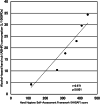The effect of a 5-year hand hygiene initiative based on the WHO multimodal hand hygiene improvement strategy: an interrupted time-series study
- PMID: 32460892
- PMCID: PMC7251720
- DOI: 10.1186/s13756-020-00732-7
The effect of a 5-year hand hygiene initiative based on the WHO multimodal hand hygiene improvement strategy: an interrupted time-series study
Abstract
Background: A World Health Organization (WHO) guideline-based multimodal hand hygiene (HH) initiative was introduced hospital-wide to a nonteaching Japanese hospital for 5 years. The objective of this study was to assess the effect of this initiative in terms of changes in alcohol-based hand rub (ABHR) consumption and the Hand Hygiene Self-Assessment Framework (HHSAF) score.
Methods: The consumption of monthly hospital-wide ABHR was calculated in L per 1000 patient days (PDs). The change in ABHR consumption was analysed by an interrupted time series analysis with a pre-implementation period of 36 months and an implementation period of 60 months. The correlation between annual ABHR consumption and the HHSAF score was estimated using Pearson's correlation coefficients.
Results: The annual ABHR consumption was 4.0 (L/1000 PDs) to 4.4 in the pre-implementation period and 10.4 to 34.4 in the implementation period. The HHSAF score was 117.5 (out of 500) in the pre-implementation period and 267.5 to 445 in the implementation period. A statistically significant increase in the monthly ABHR consumption (change in slope: + 0.479 L/1000 PDs, p < 0.01) was observed with the implementation of the initiative. Annual ABHR consumption was strongly correlated with the annual HHSAF score (r = 0.971, p < 0.01).
Conclusions: A 5-year WHO-based HH initiative significantly increased ABHR consumption. Our study suggested that the HHSAF assessment can be a good process measure to improve HH in a single facility, as ABHR consumption increased with the HHSAF score.
Keywords: Alcohol-based hand rub; Compliance; Hand hygiene; Infection prevention; Multimodal initiative; World Health Organization.
Conflict of interest statement
All listed authors have no conflicts of interest to disclose.
Figures


Similar articles
-
Ten years of hand hygiene excellence: a summary of outcomes, and a comparison of indicators, from award-winning hospitals worldwide.Antimicrob Resist Infect Control. 2024 Apr 19;13(1):45. doi: 10.1186/s13756-024-01399-0. Antimicrob Resist Infect Control. 2024. PMID: 38637873 Free PMC article.
-
Do wearable alcohol-based handrub dispensers increase hand hygiene compliance? - a mixed-methods study.Antimicrob Resist Infect Control. 2018 Nov 23;7:143. doi: 10.1186/s13756-018-0439-5. eCollection 2018. Antimicrob Resist Infect Control. 2018. PMID: 30534364 Free PMC article.
-
[A multimodal strategy to improve adherence to hand hygiene in a university hospital].Rev Calid Asist. 2017 Jan-Feb;32(1):50-56. doi: 10.1016/j.cali.2016.06.011. Epub 2016 Sep 7. Rev Calid Asist. 2017. PMID: 27614929 Spanish.
-
What is new with hand hygiene?Curr Opin Infect Dis. 2020 Aug;33(4):327-332. doi: 10.1097/QCO.0000000000000654. Curr Opin Infect Dis. 2020. PMID: 32657970 Review.
-
Current issues in hand hygiene.Am J Infect Control. 2019 Jun;47S:A46-A52. doi: 10.1016/j.ajic.2019.03.024. Am J Infect Control. 2019. PMID: 31146850 Review.
Cited by
-
Ten years of hand hygiene excellence: a summary of outcomes, and a comparison of indicators, from award-winning hospitals worldwide.Antimicrob Resist Infect Control. 2024 Apr 19;13(1):45. doi: 10.1186/s13756-024-01399-0. Antimicrob Resist Infect Control. 2024. PMID: 38637873 Free PMC article.
-
Enhancing infection prevention and control through hand hygiene compliance in six Ugandan hospitals using quality improvement approaches.Front Public Health. 2024 Oct 22;12:1465439. doi: 10.3389/fpubh.2024.1465439. eCollection 2024. Front Public Health. 2024. PMID: 39502813 Free PMC article.
References
-
- Pittet D, Hugonnet S, Harbarth S, Mourouga P, Sauvan V, Touveneau S, Perneger TV. Members of the infection control Programme. Effectiveness of a hospital-wide programme to improve compliance with hand hygiene. Lancet. 2000;356:1307–1312. - PubMed
-
- Allegranzi B, Pittet D. Role of hand hygiene in healthcare-associated infection prevention. J Hosp Infect. 2009;73:305–315. - PubMed
-
- Stone SP, Fuller C, Savage J, et al. Evaluation of the national Cleanyourhands campaign to reduce Staphylococcus aureus bacteraemia and Clostridium difficile infection in hospitals in England and Wales by improved hand hygiene: four year, prospective, ecological, interrupted time series study. BMJ. 2012;344:e3005. - PMC - PubMed
-
- World Health Organization . WHO guidelines on hand hygiene in health care. Geneva: WHO; 2009.
MeSH terms
Substances
LinkOut - more resources
Full Text Sources
Medical
Miscellaneous

